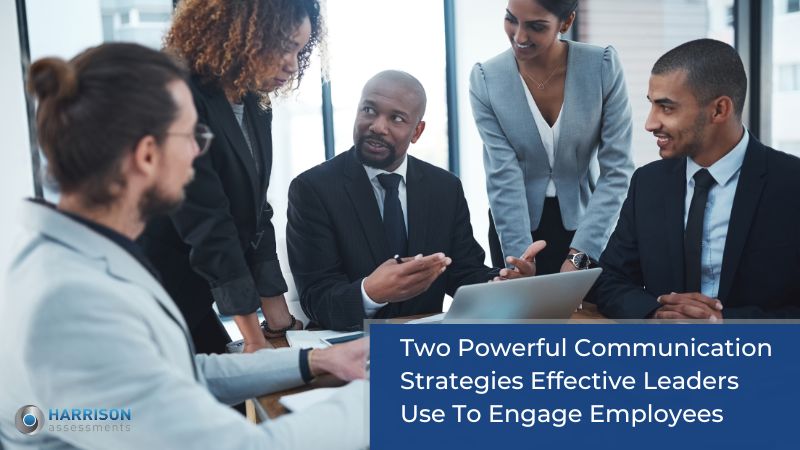
Communication is the backbone of strong leadership, employee engagement, and overall business success. Leaders who use effective communication strategies inspire their teams, set clear expectations, provide constructive feedback, and maintain strong relationships with stakeholders.

After analyzing over 30 years of global job performance and employee engagement research, conducted utilizing Harrison Assessment's SmartQuestionnaire, we were able to gain insight into the communication strategies used by effective leaders, and what employees want from their managers.
One might expect to see data showing that employees want their managers to be more respectful or diplomatic. In fact, that is true. Only 25% of employees are fully satisfied with their manager's level of diplomacy or respect when communicating. What was surprising, however, was how much less satisfied employees were with their manager's level of directness or straightforwardness, in other words, their ability to be frank.
Only 15% of employees were fully satisfied with their manager's ability to communicate with directness. Additionally, employees indicated that receiving frank communication is almost twice as important as receiving respectful or diplomatic communication.
The error in thinking that managers make is that these two modes of communication (frank vs. diplomatic) are in competition. According to our research, the most successful managers can combine being direct or frank with being respectful and diplomatic. This takes significantly more skill but is far more effective.
Managers who are diplomatic but not frank are clearly less successful because they fail to create clarity and effectively guide their employees. Managers who are frank but not diplomatic have even less success because they tend to be blunt. This communication style can damage relationships, destroy motivation, and can even cause legal problems, not to mention significantly increase employee turnover.
Frankness and diplomacy are often viewed as being opposite and mutually exclusive. However, they actually have a paradoxical and synergistic relationship. Learning to combine these paradoxical elements in a business setting leads to improved communication, employee engagement, and productive interactions between team members.
Frankness enables you to be truthful. Diplomacy enables your truth to be received. That's why effective communication requires using both frankness and diplomacy. But how can they be combined?

Diplomacy lays the groundwork for frankness and is especially important when you need to give someone feedback or you have conflicting interests or viewpoints.
Here are some basic tips to use diplomacy in your approach:
The key is to set aside whether you agree and focus on helping people to feel understood. Objectively explore their views and how they came to them before expressing a contrary view. This will usually defuse emotional situations.
Only after a relationship is built can frankness be successful. The goal in the end is to get your communication across and have it well-received. Employees who feel understood, respected, and guided are far more likely to be engaged.
Diplomacy is a great foundation for communication, but without frankness, it fails to give employees the essential feedback they need and want. Employees need this clarity to know where they stand and how to reach their employment goals.
When frankness is combined with diplomacy, leaders create an environment of trust, transparency, and accountability. On the other hand, if leaders are frank but not diplomatic, it can damage engagement and lead to higher employee turnover. Therefore, frankness should not be used as a tool on its own.
Effective leaders who combine frankness and diplomacy can express their thoughts and opinions in a direct and honest manner, while also being sensitive to the needs and self-esteem of others. They understand that diplomacy is not a matter of avoiding conflict but is a means to finding common ground, attaining mutual respect, and cooperating to achieve a common goal.
Most importantly, when frankness is combined with diplomacy it reflects caring for rather than hurting others. Leaders who apply this communication strategy set the tone for the organization which encourages employees to do the same.
It's imperative to use open-ended queries at first and avoid reacting inappropriately. Make sure to explore and listen so you're able to fully comprehend each situation. This process usually reveals realities you weren't aware of which could lead to a greater understanding and more powerful solution. For example:
You'll notice that most of the above is using diplomacy and frankness is used as a means of being truthful at a point when the employee is ready to receive it.
Here are some common workplace scenarios to demonstrate how to approach communication using diplomacy and frankness:
An employee has created a marketing presentation that is, if you were being honest, dreadful and disappointing.
1. Rather than blurting out an emotional reaction, start by asking who is the intended audience, and what impact they are seeking to have on the intended audience. Listen and acknowledge their ideas. Also acknowledge aspects you think are on point or useful and any statements with which you agree.
2. Provide context for your response. For example, you could say it is an important presentation and you're concerned that it will not have the desired impact. Framing your thoughts in terms of your concerns is a deeper level of being truthful and demonstrates an appropriate level of humility and receptiveness.
3. Be constructive by giving specific examples about how the desired impact could be achieved. Address these specific issues rather than making broad generalizations that only serve to dump your emotions.
A longtime employee who usually does an outstanding job has not completed a task in a satisfactory manner.
In this situation, it is especially important you create context to avoid the employee responding defensively.
For example, begin the communication by acknowledging what they usually do well. This ensures that they will not take your comments out of context. Then ask specific questions to get to the root cause. For example, were there any obstacles when working on the task such as time constraints or lack of resources?
Don't assume that they willfully did a poor job or were incompetent. Once you have sufficiently explored the issue, create an action plan that incorporates steps you would like to see them take to improve results.
Someone new to their role or position has made an egregious error.
Again, it's important to avoid an emotional response. First consider if the error could have been the result of insufficient training or guidance as this will usually be the case. If so, acknowledge responsibility for this lack of training and guidance. Consider what the employee needs to learn or develop and guide them accordingly.
Be specific about the developmental areas and arrange for further training related to those areas. End the communication in a positive tone by stating something encouraging. For example, point out that errors are a part of learning, and that practice will enable them to improve with such tasks.

By combining both frank and diplomatic, you create an environment that encourages collaboration, problem-solving, and accountability. You facilitate employee engagement by listening and providing regular feedback. This strategy results in employees feeling valued and motivated. And when employees see you combine respect with honesty, they are more likely to respond positively and learn those skills themselves.
Learning and practicing the skills related to this communication paradox builds relationships and enables the resolution of issues. Learning these skills in the workplace may also help build stronger relationships with your spouse and children at home.
Building these paradoxical skills can improve your reputation, as people will view you as being honest, trustworthy, and able to handle difficult conversations effectively. This supports your career advancement and salary increases.
Combining frank and diplomatic communication, enables you to exchange information and opinions in a clear and respectful manner, leading to others valuing your opinions and requesting collaboration when making decisions.
When you practice combining frankness and diplomacy, it leads to better teamwork and collaboration, as you can work through conflicts. This builds a positive organizational culture that guides and supports new employees to succeed.
Clear and respectful communication leads to less misunderstandings and confusion, thus increasing productivity.
Employees who work in organizations that value combining a frank and diplomatic communication strategy tend to be more satisfied with their jobs and less likely to seek employment elsewhere.
Effective communication strategies are essential for successful leadership, employee engagement, and organizational success. Practicing the communication paradox by combining frankness and diplomacy creates an environment of trust, respect, and motivation, leading to increased employee engagement, job satisfaction, and productivity.
Harrison Assessments' Paradox technology is uniquely able to provide dynamic, actionable insights into you and your team's communication traits. Ask us today how we can help with this crucial understanding to develop your team.


